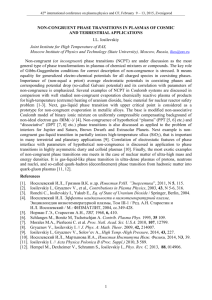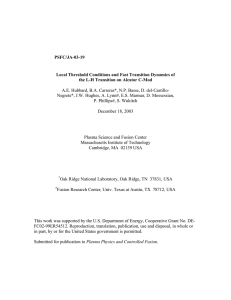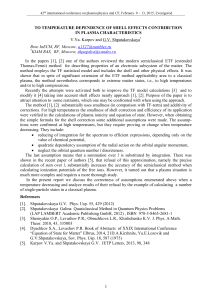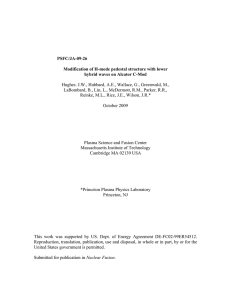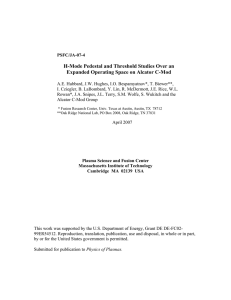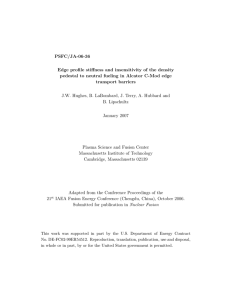Document 10916310
advertisement
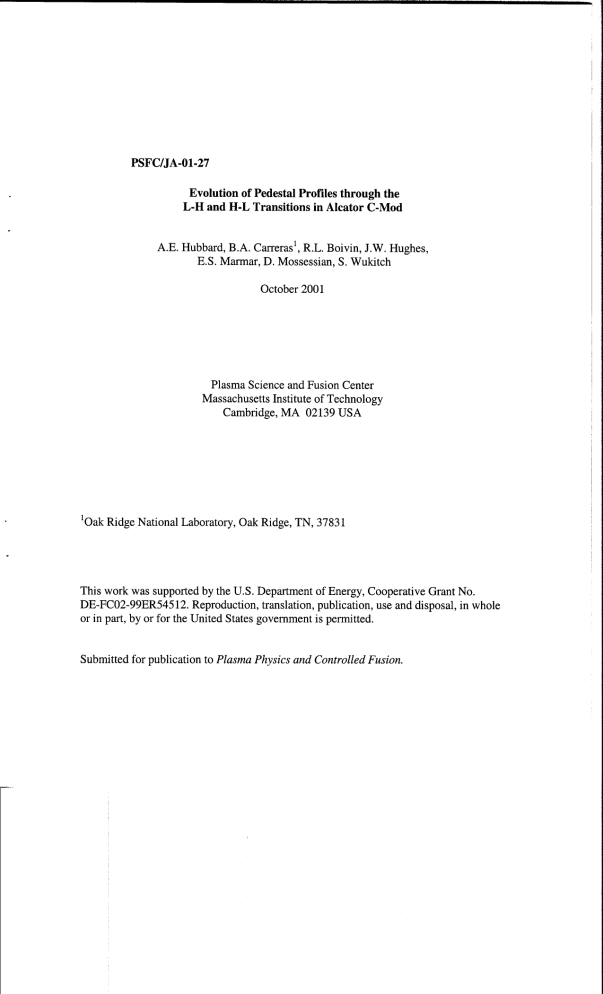
Evolution of Pedestal Profiles through the L-H and H-L Transitions in Alcator C-Mod A. E. Hubbard, B. A. Carreras*, R.L. Boivin, J. W. Hughes, E. S. Marmar, D. Mossessian, S. Wukitch MIT Plasma Science and Fusion Center, Cambridge, MA 02139, USA *Oak Ridge National Laboratory, Oak Ridge, TN 37831, USA ABSTRACT Local edge electron parameters are measured in the Alcator C-Mod tokamak, during discharges in which input power is continuously ramped up and down, leading to transitions from the low-confinement (L) to high confinement (H) mode and back to Lmode. This allows measurement of the accessible portions of the non-monotonic fluxgradient relationship proposed by models of the H-mode as a critical transition. Results are consistent with a dependence of conductivity χ on temperature gradient, having a very sharp decrease above a critical value. Other possible flux-gradient relations are also examined, and the data are compared with theoretical formulations. The initial transient of pedestal energy in the first few ms after the L-H transition is also analysed and found to be consistent with a sudden decrease in χ across the pedestal region. Submitted to Plasma Physics and Controlled Fusion September 2001 Corresponding Author: Amanda Hubbard MIT Plasma Science and Fusion Center, NW17-113 175 Albany St., Cambridge MA 01239, USA Hubbard@psfc.mit.edu Tel: (617)253-3220 Fax: (617)253-0627 1 1. Introduction In studying the transition mechanism from a low confinement mode (L-mode) to a high confinement (H-mode), three levels of time scales can be considered. There is the fast time scale of the transition (of the order of 100 µs). A great deal of effort has been dedicated to get diagnostics on this time scale, to determine the cause of the transition by observing a succession of fast changes in the parameters1 . However, if the L to H transition is a critical transition such a chain of causal events does not necessarily exist. Less attention has been paid to the other time scales in the transition process. There is an intermediate time scale, of the order of milliseconds, in which the density and temperature profiles respond to the transition. Finally, one can consider the evolution of different equilibria responding to changes in the power and going through the full hysteresis cycle L–H–L. Exploration of these scales provides important information on the nonlinear structure of the fluxes, which is essential to understand in order to explain the bifurcation properties.2 In this paper, we will consider these last two time scales and try to address some questions about the transition that can be provided by the plasma response. The Alcator C-Mod tokamak3 is well suited to such studies, since it has a flexible ICRF power heating system that allows us to slowly and continuously vary the power across the transition threshold and then follow a controlled evolution back to L-mode. There is also an extensive set of pedestal diagnostics, described in the following section. This paper focusses on measurements of local fluxes and gradients on the slow, quasi-equilibrium, time scale. Possible functional relations are examined and compared to theoretical formulations in Section 3. The faster transient in the first few ms after the L-H transition is briefly discussed in Section 4. 2. Description of the experiments. Dedicated threshold experiments were carried out on the Alcator C-Mod tokamak, at a toroidal field of 5.4 T and plasma current of 0.8 MA. Under these conditions, with q95 ~ 4.7, H-modes are typically in the 'Enhanced D-alpha' (EDA) regime, in which continuous, quasi-coherent edge fluctuations enhance the particle transport over ELM-free levels, leading to steady density and impurity levels4 . ICRF power at 80 MHz is ramped up and down linearly, as shown in Figure 1, leading to an L-H and subsequent H-L transition. A range of ramp rates and power levels, up to 2.6 MW, have been used, in two separate run campaigns. The line averaged L-mode target density ne was also varied, from 1.2-2.2 x1020 m-3 . The net power flux Q at the top of the edge pedestal is derived assuming 7080% RF absorption, adding the ohmic power, and subtracting the radiation within the pedestal region, measured by bolometer arrays. The pedestal diagnostics available on Alcator C-Mod are described in detail elsewhere5 . Because of the high-density characteristic of the Alcator C–mod plasmas, we assume that Te = Ti and work with electron channel measurements. For fast time resolution, δt ~1 ms, we use Te from electron cyclotron emission (ECE) and density derived from visible bremsstrahlung emissivity (VB), assuming constant Zeff. Since the 9-channel ECE instrument is insufficient to resolve the pedestal, core gradients were extrapolated to a radius of ψ =0.95, which is typically near the top of the pedestal, to estimate Tped(t) and derive the averaged gradients ∇Teff between this point and the separatrix. nped(t) is taken at 2 the same location. Typical time evolution of these parameters is shown in Fig. 1. In the most recent campaign, these diagnostics were supplemented by an edge Thomson scattering (ETS) diagnostic with 1.5 mm resolution, providing pedestal profiles of ne and Te every 33 ms6 . ETS profiles were used to cross-check the extrapolated values at ψ =0.95, as well as to measure the maximum pedestal gradients. These are typically a factor of two higher than the averaged gradients, but have a similar time dependence. Due to the statistical uncertainties inherent in Thomson scattering, however, they tend to have larger variation between time points. 3. Flux - gradient relationship over long time scales The evolution of the plasma edge density and temperature on a slow time scale during power ramps can be considered as a sequence of equilibria at different heat fluxes. We can then explore the structure of the flux as a function of the gradients in n and T. Most models proposed for the L-H mode transition, recently reviewed by Connor and Wilson7 , give a non-linear, double-valued function of flux versus edge gradients, through a bifurcation in transport above some critical gradient. These models differ in the fluxes (either power or particle) which are proposed to control the transition, in the gradients which control the transport, and in the functional form of the decrease in transport coefficients. The choice of variables for this analysis is guided by experiment as well as theory. Since the H-modes were triggered by ramping up PRF at constant ne, power appears more important than particle flux in this case. Noting that Te,ped in Fig. 1 responds to power in both L and H-mode, while the density shows a bifurcation at the transitions but is otherwise nearly independent of power, it seems that the local parameter controlling the transport must include temperature (eg. ∇T or ∇p ). This is consistent with previous studies on C-Mod which have shown that for fixed plasma configuration, there is a threshold value of edge temperature at the L-H transition8 . Since Te at the separatrix is nearly constant due to SOL power balance, Te,95 and ∇T are closely linked8,9 . The prevalent theoretical picture of transport barrier formation is that it is due to E × B shear flow suppression of turbulence. In this case the relevant variable is duE/dr, where uE ≡ cEr B is the E × B flow and Er is the radial electric field. An expression of the thermal conductivity that includes the effect of shear flow suppression of the form χa χ = χH + (3.1) γ 1 + α (du E / dr ) has been proposed10,11 , where χa is the anomalous thermal conductivity, χH is the reduced level in the H-mode barrier, and α and γ are constants. However, uE is not measured directly on C-Mod or most other experiments, so various approximations have been made. In Ref. 10, Hinton assumes that χ is the sum of the ion neoclassical contribution and a turbulent contribution modified by the poloidal rotation shear, which can be expressed in terms of ∇T resulting in χa χ = χH + (3.2) 4 1 + λa ( ∂ T ∂ r ) In Ref. 11, in contrast, Hinton and Staebler neglect the poloidal and toroidal flow terms 3 and also the second order derivatives, giving duE c dni dpi ;− 2 dr eBni dr dr They assume that γ = 2, that ni is weakly varying in time and the temperature gradient dominates over the density gradient, giving χa χ = χH + 2 2 1 + α ( dni dr ) ( dTi dr ) However, in our experiment ne,ped varies significantly and, since ne,sep is roughly constant, it tends to cancel out much of the variation in dn/dr and dp/dr. One can instead write Eq. du c 1 LT dT 3.3 as E = − . If one neglects the variation in the density and 1+ dr eB Ln Ln dr temperature scale lengths Ln and LT instead of in the absolute density, a dependence of χ on dT/dr similar to Eq. 3.2 is obtained, but with an exponent γ = 2 instead of 4. A dynamical model coupling fluctuation evolution to the flow and pressure transport has also been proposed12 . In this model, there is no simple expression for the effective nonlinear diffusivity. However, by slaving the fluctuations to the shear flow one gets a simple relation between the rms fluctuation level, which is proportional to the turbulence diffusivity Da in this model, and the shear flow. This gives an expression for the diffusivity: 3 3 D = D H + Da 1 − α ( dn dr ) Θ 1 − α ( dn dr ) dn dr (3.5) Here, Θ is the Heaviside function that models the shear flow suppression of turbulence. This model considered only particle fluxes and density gradients for simplicity, but should also apply to the more general case of thermal transport. Recently it has been pointed out that second derivatives of n and/or T should be important for suppression of turbulence, which would add an additional term to the denominator of Eq. 3.2 or 3.4 and could alter the form of the flux-gradient relation significantly13 . However, as second derivatives cannot be measured with sufficient accuracy, we restrict ourselves for this initial study to considering first-order gradients, and the functional forms proposed above. Assuming that half of the power flows through the electron channel, the local power balance is given by Q / 2 A = − χ eff ne k∇ Te , where A is the plasma surface area and k is the Boltzmann constant. In Fig. 2, −∇ Teff from ECE is plotted against Q / 2 kAn e,p e d at 5 ms intervals. The slope of the curve thus gives χeff directly, an advantage of plotting vs the gradient rather than Te, and the decrease from L to H-mode is clearly evident. Figure 2(a) is for an L-mode target density ne = 1.1 x1020 m-3 , with points from two discharges combined to give a larger range of input power, while 2(b) is from two higher density discharges with ne = 2.2 x1020 m-3 . The open diamonds indicate time points in which Te, ne and/or input power are changing rapidly and conditions are not in equilibrium, and are not used in fits. The curves represent best fits to the other points (+), assuming χeff depends only on ∇T . The dashed line (Fit A) uses Eq. 3.2, ie. taking γ=4, while the solid line (Fit B) represents Eq. 3.5, but with dT/dr used rather than dn/dr. The free parameters are χa, 4 (3.3) (3.4) χH, and a 'threshold' gradient ∇Tc , which sets the constants α and λa. Both fits give similar values for χa (0.53-0.8 m2 /s) and χH (0.09-0.12 m2 /s), with no significant variation with density. Eq. 3.5 has a sharper drop in χ above the threshold, and gives a somewhat better fit to the data; γ=6 would be required in Eq 3.2 to give a similar fit, while γ=2, as assumed in Ref. 11, gives too gradual a change with∇T . ∇Tc for each fit shows little variation between low and high-density cases, consistent with this being a fundamentally important parameter for the transition. The 'critical' values are 10.6 and 10.7 keV/m respectively for Fit A, and 18.6 and 16.4 keV/m for Fit B. Dependences on other gradients are also possible. In Fig. 3 we plot the same dataset, but with the horizontal axis - ne∇ Te , which approximates the average pressure gradient. The vertical axis is now Q/2A, so that the slope again represents χeff. This again shows a bifurcation in transport, but, since density increases in H-mode, the dependence on ne∇ Te does not have to be so sharp. In this case the functional form of Eq. 3.2 gives the better fit. However, the 'threshold' value of ne∇ Te is ~ 40% higher in the higher density data set, so that if pressure gradient is the controlling variable, one would have to postulate a threshold which increases with ne. Power ramp experiments were recently repeated with edge Thomson scattering, which allows more accurate evaluation of gradients. Figure 4 is for a discharge with very similar conditions to that of 2(a). If n and T from ETS at ψ=0.95 are used, results are very similar to those in Figs. 2 and 3. Figure 4(a) shows Q / 2kAne vs ∇T , as in Fig. 2, where the gradients and ne are in this case evaluated at the pedestal midpoints. This choice gives systematically larger χeff values, but the functional dependence, and the threshold gradient, is consistent with that measured using ECE and VB. The higher spatial resolution of ETS also makes it possible to evaluate dependences on more complicated variables, such as duE/dr from Eq. 3.3, without approximating the scale lengths LN or LT . The horizontal axis in Fig. 4(b) is X ≡ 1 ne2 ( dne dr )max ( dpe dr ) max . In order that the slope of the curves still approximately represents χeff, the vertical axis in this case is 3Q / 2kAne Ln where Ln ≡ ne ∇nmax and the factor of 3 accounts roughly for (1+LT /Ln ). One can also see a bifurcation of χ between L and H modes using this variable. The solid and dashed curves represent the same functional dependences considered above, while the dotted curve (Fit C) is for γ=2 as in Eq. 3.4. The higher scatter in the gradients, however, tends to obscure the dependence on flux in each regime; X can vary by a factor of two between adjacent time points and one cannot easily determine Xcrit or choose the best fit among the various functions plotted. 4. Intermediate time response to the L-H transition. In looking for the profile response to the transition in the intermediate time scale range, two main scenarios emerge in theoretical models of the dynamics near the L-H transition 1,2,7,14 . In one, the transition happens in a very narrow radial region at the plasma edge and propagates inwards building up the pedestal. This propagation rate depends on how much 5 the power flux Γο =Q/A exceeds the critical flux Γc and time response of the change in energy density p (t ) = nkT at the pedestal is given by15 p% p ( t ) ≈ t [ (Γ 0 − Γc ) a ] . An alternative scenario shows the transition happening simultaneously over the broad radial range, x T < x < a, of the whole pedestal. The response of the energy density in this case can be evaluated from intermediate asymptotics16 . For the time scales of interest, x χ t p% ( x, t ) = Γ0 1 − H Φ χ A χ H χ H t 2 2 − y4 2 y − y2 where Φ is a dimensionless functionΦ ( y ) = e − y 1− e dy . The π π ∫0 dominant time response is given by the t factor multiplying Φ in Eq. (4.1). We have attempted to explore these differences experimentally using the time response of ne and Te. If the plasma responds to the incremental flux, Γ0 −Γc, one would expect that the initial rate of rise dp% / dt to depend on the rate at with which the power is ramped through the threshold. Instead, it was found to be independent of dΓ/dt, over a wide range of the ramping rate. The magnitude of p% (t ) at the top of the pedestal is consistent with Eq. 4.1, taking x << χ H t and using values of χ estimated in the previous section5 . The transients p% (t ) have also been fit with functions of the form C tβ . The derived exponent β shows considerable variation from discharge to discharge, lying typically between 0.5 and 1.0. Details of this analysis, including possible systematic dependences of β, will be reported in a separate publication. In summary, while the rates of rise in pressure are more consistent with a near-instantaneous drop in χ across the pedestal, we cannot rule out some rapid propagation of the 'front' or other, perhaps combined, scenario. 5. Discussion and Conclusions The power ramp experiments reported here have shown that one can extract more information by following local parameters during the whole L-H-L cycle than by simply assessing parameters at the transition, as has been previously done for data from C-Mod and several other tokamaks8, 9,17 . The disadvantage is that dedicated discharges are required, so that fewer transitions can be studied; the two approaches are thus complementary. For the new C-Mod data, it has been shown that plotting Q/n vs ∇T gives a consistent, strongly double-valued function. The slope χeff drops by at least a factor of six between L and H-mode, above a threshold of ∇Tcrit ~11 keV/m. The decrease above ∇Tcrit must be very sharp, and is consistent with Eq. 3.5, and also with Eq. 3.2 if the value of γ exceeds 4; 'soft' transition functions do not fit these data. However, the fluxgradient relation is not unique; other gradient functions such as ∇p , ∇p / n or 1 ne2 ∇n∇p also give double-valued functions. The 'threshold' gradients tend to show more variation in these cases, and the experimental curves more scatter. While we have not explicitly considered the influence of second order derivatives, it is worth noting that all of the fluxgradient relations considered are double-valued, while Ref. 13 implies that sufficiently 6 (4.1) strong curvature terms could render the dependences monotonic. It may well be that second and first derivatives are strongly correlated, at least well away from the transition times. The technique used in this paper is a useful means of experimentally exploring the nonlinear structure of the fluxes and testing predictions of H-mode transition models. This approach hopefully will lead to more specific predictions, allowing us to distinguish clearly between various possible driving fluxes and gradients. It should be noted that the results presented here, in which power flux triggers the L-H transition, do not preclude other triggers in different experimental scenarios, such as the pellet-induced H-modes on DIII-D18 . Further work will include extending the range of global parameters in the power ramp experiments, and combining more discharges to reduce the scatter in measured gradients. We will also explore in more detail the fast evolution in the first few ms after the L-H transition, to try to understand better the time response under different plasma conditions. References 1 Burrell K H 1997 Phys. Plasmas 4, 1499. Yoshizawa A, Itoh S.-I, Itoh K and Yokoi N 2001 Plasma Phys. Control. Fusion 43, R1. 3 Hutchinson I.H., et al. 1994 Phys. Plasmas 1 1511. 4 Greenwald M, et al 1999 Physics of Plasmas 6(5), 1943-9. 5 Hubbard A E, Boivin R L, Granetz R S et al 2001 Phys. Plasmas 8 (5), 2033-2040. 6 Hughes J W, Mossessian D A, Hubbard A E et al 2001 Rev. Sci. Instrum. 72, 1107. 7 Connor J W and Wilson H R 2000 Plasma Phys. Control. Fusion 42, R1-R74 8 Hubbard A E, et al, 1998 Plasma Physics Control. Fusion 40 (5), 689-92. 9 Groebner R J, Thomas D M and Deranian R D, 2001 Phys. Plasmas 8(6), 2722. 10 Hinton F L 1991 Phys. Fluids B 3, 696. 11 Hinton F L and Staebler G M 1993 Phys. Fluids B 5, 1281. 12 Carreras B A, Newman D, Diamond P H and Liang Y-M 1994 Phys. Plasmas 1, 4014. 13 Taylor J B, Connor J W and Helander P 1998 Phys. Plasmas 5, 3065. 14 Diamond P H, Lebedev V B, Newman D E and Carreras B A 1995 Phys. Plasmas 2, 3685. 15 Lebedev V B and Diamond P H 1997 Phys. Plasmas 4, 1087-1096. 16 Barenblatt G I, “Scaling, self-similarity, and intermediate asymptotics”, 1996 Cambridge University Press, Cambridge, England. 17 Suttrop W, et al, 1997, Plasma Phys. Control. Fusion 39 2051-2066. 18 Gohil P, et al, 2001, Phys. Rev. Lett. 86, 644. 2 7 Figure 1: Time traces for a typical C-Mod power ramp discharge, 990915013. Top panel (a), shows launched RF power (solid), core radiation (dotted curve) and net power (dashed). (b) Horizontal Dα==emission, showing transition to EDA H-mode at 0.654 secs, and back transition at 1.324 secs. (c) ne,ped from VB (solid) and line averaged density (dashed). (d) Te,ped from ECE. (e) average pedestal gradient −∇Teff . (a) (b) Figure 2 Nomalized power flux Q / 2kAne, ped vs −∇Teff for two different densities (a) ne =1.1 x1020 m-3 (two discharges including that in Fig. 1), (b) ne =2.2 x1020 m-3 . Only the slowly varying points (+) are used in fitting the model predictions of Eq. 3.2 (dashed) and Eq. 3.5 (solid). (a) (b) Figure 3. Q/2A vs − ne , ped k ∇Teff , for the same dataset as in Fig. 2. The curves represent the same equations, but with the new dependent variable. (a) (b) Figure 4: Data from ETS for power ramp discharge 1010726018 with ne =1.6 x1020 m-3. (a) Q / 2kAne, mid vs −∇Tmax , showing similar relations and critical gradient to those in Fig. 2. (b) Renormalized flux 3Q / 2kAne Ln vs 1 ne2 ( dne dr )max ( dpe dr ) max , for comparison with Ref. 11. The dotted curve is for γ=2, while the solid and dashed curves are for the same functions as in previous fits.



